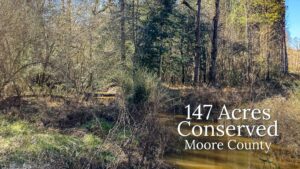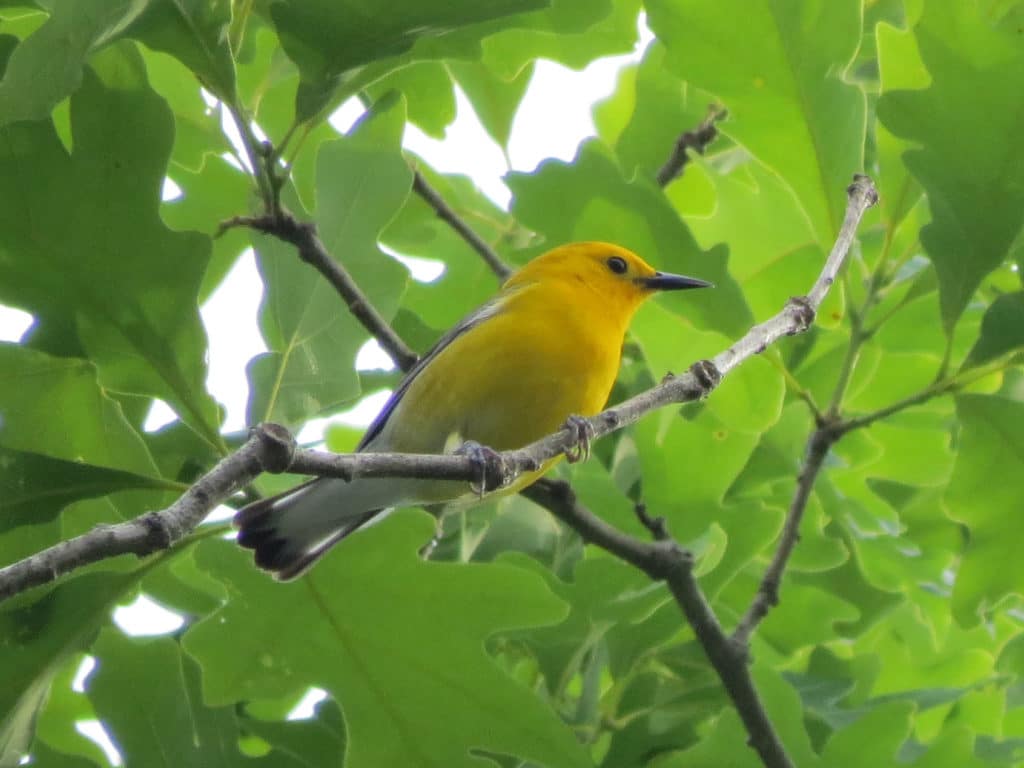

by Ruth Ann Grissom
April 10, 2018
April – the month that quickens the pulse of birders across the Piedmont. Songbirds also feel the stirring, the restless urge to head north. In the coming weeks, millions will wing their way from winter homes in the tropics to breeding grounds in the Piedmont and beyond. In the Uwharries, we’ll delight in glorious birds like the indigo bunting and American redstart all summer, and we’ll thrill to glimpses of the rose-breasted grosbeak and black-throated blue warbler as they transit the region.
But there’s a shadow to the joy of spring migration. Even as we raise our binoculars to scan the tree canopy, we can’t escape the fact that many bird species are suffering steep population declines. This harkens back to the early 20th century when wading birds were being slaughtered for commerce. Their feathers were a popular adornment for ladies’ hats. Many were pushed to the brink of extinction. Their possible demise inspired the Migratory Bird Treaty Act of 1918, which protected the birds and also helped expand the national wildlife refuge system. Their numbers soon rebounded.
Audubon and other conservation groups have joined to celebrate the anniversary of this hallmark legislation. The Year of the Bird is part celebration, part cautionary tale. The task before us is infinitely more difficult than the remedy implemented a century ago. The threats are more ingrained, more widespread and diffuse. These include climate change, habitat loss, non-native species, changes in agricultural and forestry practices, house cat predation, collisions with man-made structures, light pollution and extreme weather events. It will clearly take more than a single act to save migratory songbirds.
To complicate matters, neo-tropical migrants don’t recognize geo-political boundaries. The golden-winged warbler has come to embody the need for international cooperation. In the U.S., the birds breed in two distinct geographic regions. The Great Lakes population has remained relatively stable while the Appalachian population has declined by 98%, despite habitat restoration efforts.
According to a recent Audubon article (http://www.audubon.org/news/the-mystery-golden-winged-warblers-decline-starts-unravel), scientists have now discovered these two populations also winter in different places. Birds that breed around the Great Lakes migrate to Central America, while the Appalachian birds go to Venezuela, where there has been significantly more deforestation. For the Appalachian population to survive, a similar commitment to habitat restoration will be needed on the golden-wing’s wintering grounds. Political and economic instability in Venezuela could make that even more challenging.
Closer to home, the Uwharries lie in one of the state’s four priority areas for the Forest Landbird Legacy Program (http://nc.audubon.org/landing/forest-legacy-landbird-project-0), a joint effort by N.C. Audubon, N.C. Wildlife Resources Commission, N.C. Forest Service, Natural Resources Conservation Service and U.S. Fish and Wildlife Service. In these regions, large blocks of forest provide habitat for species of concern such as the whip-poor-will, wood thrush and prothonotary warbler.
The flashy prothonotary, named for papal clerks who wore bright yellow robes, nests in wooded swamps and bottomland forests through much of the Midwest and Southeast. Many of these rich, productive forests have been lost to farming, logging or a dam’s backwaters. Tillery and Badin each consumed over 5,000 acres of prime habitat. These forests were once home to the Carolina parakeet, and their loss no doubt contributed to its extinction, but we still have the chance to save the prothonotary warbler. This little bird illustrates the importance of conservation and management of public and private land along the Yadkin, Pee Dee, Uwharrie and other rivers in the region.
To assist landowners in these four priority areas, the Forest Landbird Legacy Program provides technical advice on improving forest health and applying for funds to offset management costs. This program focuses on tracts of at least 50 acres with trees at least 50 years old. Given that 60% of the state’s forests occur on private land, this program recognizes that publically owned parks and forests will never be sufficient to maintain healthy bird populations. Well-managed private lands are essential.
On the local level, our own backyards have become ground zero for bird conservation. “If you combined all the suburban yards in America and made them wildlife habitat, you’d be bigger than all the national parks combined,” says Curtis Smalling, N.C. Audubon’s director of conservation. To realize the full potential of this impact, we’ll have to do more than put up a few bird houses and feeders. As Doug Tallamy states so convincingly in Bringing Nature Home, native birds need native plants. But according to Smalling, 80% of the plant material in the typical yard is non-native. That leaves a lot room for improvement, but where to begin?
Audubon’s Bird Friendly Communities can make this task less daunting. N.C. Audubon created a video ( http://nc.audubon.org/conservation/conservation/bird-friendly-communities) to provide an overview. Since 2015, they have also published a list of bird-friendly plants (http://nc.audubon.org/sites/g/files/amh416/f/bird-friendly_native_plants_of_the_year_list_2015-2018.pdf). Birders can help drive demand for these plants by asking retailers to supply them. As Smalling notes, local plants will be grown by local nurseries and provided to local retailers, but they will make a difference across a broader landscape.
The Year of the Bird gives new meaning to some sound advice: think globally, act locally.
For more on the natural and cultural history of the Carolina parakeet, read Forever Gone (https://orionmagazine.org/article/forever-gone/) by Dr. J. Drew Lanham.